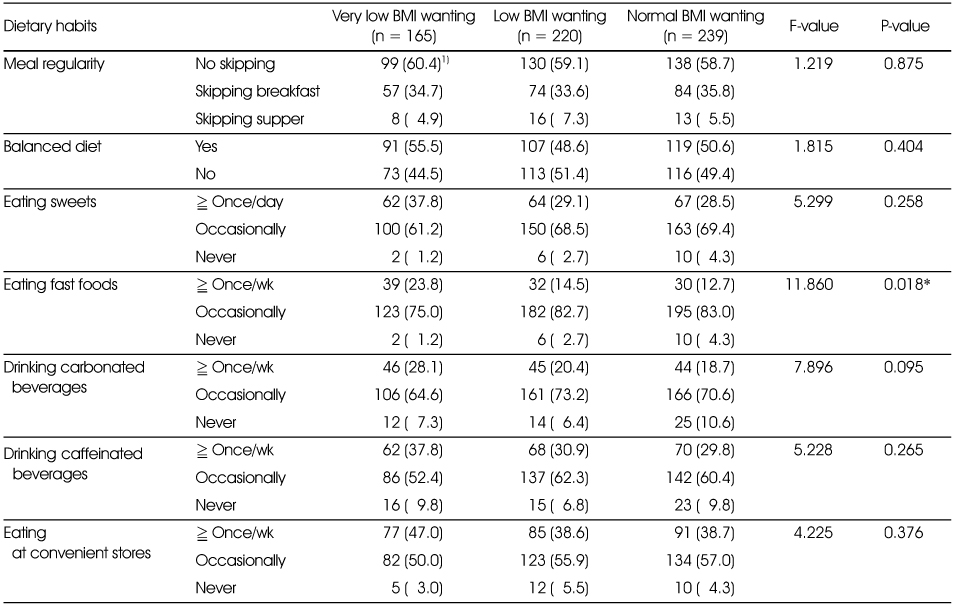Articles
- Page Path
- HOME > Korean J Community Nutr > Volume 18(4); 2013 > Article
-
Original Article
- Wanting Extremely Low BMI May be Associated with Higher Depression and Undesirable Dietary Habits in High School Girls Who were Not Overweight
- Hyeyoung Park, Hongmie Lee
-
Korean Journal of Community Nutrition 2013;18(4):344-353.
DOI: https://doi.org/10.5720/kjcn.2013.18.4.344
Published online: August 31, 2013
Graduate School of Nutrition Education, Daejin University, Pocheon, Korea.
1Department of Food Science & Nutrition, Daejin University, Pocheon, Korea.
- Corresponding author: Hongmie Lee, Department of Food Science & Nutrition, Daejin University, Pocheon 487-711, Korea. Tel: (031) 539-1862, Fax: (031) 539-1860, hmlee@daejin.ac.kr
Copyright © 2013 The Korean Society of Community Nutrition
This is an Open-Access article distributed under the terms of the Creative Commons Attribution Non-Commercial License (http://creativecommons.org/licenses/by-nc/3.0/) which permits unrestricted non-commercial use, distribution, and reproduction in any medium, provided the original work is properly cited.
- 983 Views
- 1 Download
- 4 Crossref
Figure & Data
REFERENCES
Citations

- Body Image Perception and Eating Behaviors among Male Middle and High School Students according to Weight Status in Seoul
Bo-Mi Kim, Kyung-Hee Kim
Journal of the East Asian Society of Dietary Life.2018; 28(2): 123. CrossRef - Agreement Between Actual and Perceived Body Weight in Adolescents and Their Weight Control Behaviors
Sun Mi Shin
Journal of Obesity & Metabolic Syndrome.2017; 26(2): 138. CrossRef - Body Image Perception, Eating Disorder Risk, and Depression Level according to Dieting Experience of Female High School Students in Seoul
Jisun Min, Kyunghee Song, Hongmie Lee
Journal of the Korean Dietetic Association.2016; 22(4): 241. CrossRef - The Associations between Discordance of Body Image and Physical Activities among Adults Aged 19 to 64 Years: Based on the Data from 2010 Community Health Survey
In Ae Chun, So Yeon Ryu, Jong Park, Mi Ah Han, Seong Woo Choi, Dae Sik Ko
The Korean Journal of Obesity.2014; 23(4): 274. CrossRef
Desired BMI of high school students according to gender
1) N (%)
Actual weight status of high school girls according to groups with BMI desired
1) N (%), 2) Mean ± SD
abc: Different superscripts in the same row mean significant difference among groups by Duncan's multiple range test.
***: p < 0.001
Health related lifestyle of high school girls according to BMI desired
1) N (%)
*: p < 0.05 by χ2 test.
Dietary habits of high school girls according to desired BMI
1) N (%)
*: p < 0.05 by χ2 test.
Weight control behaviors of high school girls according to desired BMI
1) N (%)
***: p < 0.001 by χ2 test.
Obsession to lose weights of high school girls according to desired BMI
1) Mean ± SD
ab: Different superscripts in the same row mean significant difference among groups by Duncan's multiple range test.
*: p < 0.05, **: p < 0.01 by one-way ANOVA.
Obesity stress of high school girls according to desired BMI
1) Mean ± SD
ab: Different superscripts in the same row mean significant difference among groups by Duncan's multiple range test.
*: p < 0.05, **: p < 0.01 by one-way ANOVA.
Depression symptoms of high school girls according to desired BMI
1) Mean ± SD
ab: Different superscripts in the same row mean significant difference among groups by Duncan's multiple range test.
*: p < 0.05, ***: p < 0.001 by one-way ANOVA.
1) N (%)
1) N (%), 2) Mean ± SD abc: Different superscripts in the same row mean significant difference among groups by Duncan's multiple range test. ***: p < 0.001
1) N (%) *: p < 0.05 by χ2 test.
1) N (%) *: p < 0.05 by χ2 test.
1) N (%) ***: p < 0.001 by χ2 test.
1) Mean ± SD ab: Different superscripts in the same row mean significant difference among groups by Duncan's multiple range test. *: p < 0.05, **: p < 0.01 by one-way ANOVA.
1) Mean ± SD ab: Different superscripts in the same row mean significant difference among groups by Duncan's multiple range test. *: p < 0.05, **: p < 0.01 by one-way ANOVA.
1) Mean ± SD ab: Different superscripts in the same row mean significant difference among groups by Duncan's multiple range test. *: p < 0.05, ***: p < 0.001 by one-way ANOVA.

 KSCN
KSCN








 Cite
Cite


